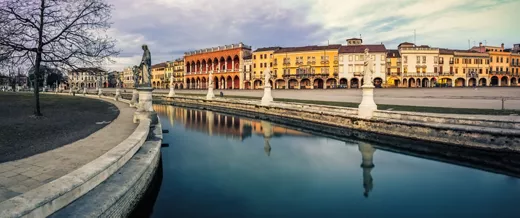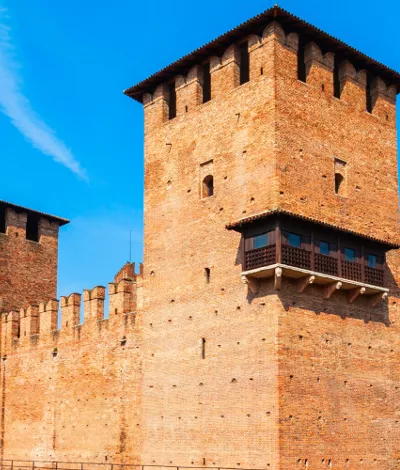Discover the charm of Verona, the city of love with a history spanning more than 2000 years
Verona is not only the city of Romeo and Juliet, but also the “Gateway to Italy”, because it showcases and foreshadows all of Italy’s beauty and cultural wealth to visitors arriving from the north. The Venetian city is enthralling thanks to an atmosphere that is rich in history and priceless beauty.
The 2000-year-old city of love
It is one of the oldest and most beautiful cities in Italy: Verona is the largest city in the Veneto region after Venice. Located next to Lake Garda, delicately nestled at the foot of the Venetian Pre-Alps and on the banks of the Adige River, it is well-loved for its breathtaking panorama and a wealth of culture that is hard not to love.


Venice
For many, the most beautiful city in the world. Venice has an eternal and poignant charm, and is today among the world capitals of contemporary art. Timeless and magical, the soul of Venice is made up of 118 islands united together by more than 400 bridges, separated by canals that act as waterways, forever bustling with gondolas and boats in a never-ending back-and-forth. Saying that it is brimming with art treasures is even disrespectful: romantic charm and history are absolutely unique.
Discover
Belluno
Lakes, valleys and mountains: the beauty of Belluno We begin exploring the Belluno province in the town of Belluno, its capital — home to the Renaissance Palazzo dei Rettori, the Civic Tower belonging to the ancient castle of the bishop-counts, and a cathedral with a 68-metre-high bell tower. Piazza dei Martiri, or Campedèl, is the heart of the city. The oldest part of the town covers from Porta Dojona to the medieval Piazza del Mercato. 20 kilometres from the city stands Zumelle Castle, originally built in Roman times, rebuilt in the 12th century. Thanks to the variety of landscapes in the shadow of the Dolomites, the area boasts striking green valleys, Alpine lakes, small villages and adrenaline-fuelled ski slopes. The most beautiful lakes include Lake Sorapis, with its turquoise waters, Lake Misurina, which glistens at sunset, and Lake Alleghe, which laps the shores of its namesake village. Nearby is the Serrai di Sottoguda nature reserve. Cortina d’Ampezzo, in the Cadore region, offers 120 kilometres of ski slopes, 60 kilometres for cross-country skiing, a snow park, 37 ski lifts, a children’s fun park and toboggan runs. Near Cortina, you can hike the Tour of the Three Peaks of Lavaredo, starting from the Auronzo refuge. In the southern part of the Belluno province lies Valbelluna, a valley carved by the Piave river nestled within the Belluno Dolomites National Park. Don’t miss the Vette Feltrine mountain range, the Brent de l’Art canyon and the Grotta Azzurra cave. In the evening, you can drive to Pedavena to enjoy a beer at the historic brewery.
Discover
Vicenza
Among the Berici Hills and Palladian Villas The province of Vicenza in Veneto promises to immerse you in beauty. Don’t miss a tour of the capital, surrounded by the Berici Hills. On one of these hills is the Sanctuary of St Mary of Mount Berico, with a Gothic and a Baroque church. In the city, we recommend visiting Piazza dei Signori, Palazzo Chiericati, the Palladian Basilica, the Olympic Theatre and the Salvi gardens. Near Vicenza is the Buso della Rana, the largest cave in Veneto, while the surroundings of the capital of Veneto are best known for housing the Palladian Villas, which have earned the city UNESCO World Heritage status. The most beautiful among these 16th-century architectural spectacles designed by Andrea Palladio are Villa Thiene, Villa Angarano and Villa Saraceno. Be sure to visit Bassano del Grappa, along the banks of the Brenta, where you can breathe in the memory of the First World War. Don’t miss the Ponte Vecchio, the Museo degli Alpini museum and the Hemingway and Great War Museum. You definitely have to try the famous grappa produced here and stroll along Viale dei Martiri for scenic views of the Sugana Valley and Monte Grappa. Vicenza is also the perfect place to discover other local beauties. In Marostica, known as the City of Chess, you can explore the iconic chessboard-shaped main square. Also worth visiting is Asiago, in the Vicentine Pre-Alps, to taste the famous PDO cheese.
Discover
Treviso
Canals, Palladian villas, villages and castles The province of Treviso, in the heart of Veneto, is famous for its delicious radicchio, but it also offers historical, artistic and scenic wonders — starting with its main town, crossed by the stunning Buranelli canal. Don’t miss the Piazza dei Signori with its palaces, the Calmaggiore arcades, the Romanesque-style cathedral and the Gothic-style church of San Nicolò. You can enjoy a beautiful walk along the walls or, just outside the city, along the banks of the Sile river. Around Treviso are some of the most beautiful Palladian villas. Among the most charming villages in Treviso is Asolo, with its splendid castle and Roman aqueduct, steeped in an atmosphere of yesteryear. The great actress Eleonora Duse, muse of Gabriele D’Annunzio, always wanted to live here. We also recommend visiting Follina, home to the Abbey of Santa Maria in Sanavalle, and Cison Valmarino, in the heart of the vineyard-covered hills where the famous prosecco is produced, between Conegliano and Valdobbiadene. Nearby is Castelbrando, among the largest castles in Europe. In Possagno you can visit Antonio Canova’s birthplace. Important battles were fought on the Monte Grappa front and along the Piave river during the First World War. History buffs will enjoy the Great War Path, which follows the course of the river.
Discover
Verona
Discover the charm of Verona, the city of love with a history spanning more than 2000 years. Verona is not only the city of Romeo and Juliet, but also the “Gateway to Italy”, because it showcases and foreshadows all of Italy’s beauty and cultural wealth to visitors arriving from the north. The Venetian city is enthralling thanks to an atmosphere that is rich in history and priceless beauty.
Discover
Padua
Through villages, villas and castles Surrounded by the beautiful Euganean Hills, the province of Padua is an area to explore. A city of art and science, the lively capital is a must-see for anyone visiting Veneto. Your tour must include the Scrovegni Chapel, a treasure trove of some of the most beautiful frescoes in Italy. Also worth a visit are the Basilica di Sant'Antonio, the Palazzo della Ragione and Palazzo del Bo, which houses the fascinating Teatro Anatomico and the chair of Galileo Galilei. You cannot leave Padua without walking around Piazza delle Erbe and Prato della Valle, a vast square surrounded by canals and a double row of statues. Not far from the city is the Euganean Hills Regional Park, an area of over a hundred green hills of volcanic origin. The Paduan landscape is dotted with villages, such as the medieval Arquà Petrarca, which welcomed the poet in the last years of his life. Also villas and castles, including the Renaissance Villa dei Vescovi in Luvigliano di Torreglia, Villa Barbarigo in Valsanzibio and the Catajo Castle in Battaglia Terme. There is no shortage of walled cities, such as Monselice and Este with their respective fortresses. But above all the medieval Cittadella, with its elliptical walls, and Montagnana, with no less than 24 watchtowers. For psycho-physical refreshment, everyone goes to the Terme Euganee, one of the oldest thermal spas in Europe. The centres of Abano Terme and Montegrotto date back to the 6th century BC, as evidenced by archaeological finds and excavations, and the beneficial and therapeutic properties of their underground waters make them a popular tourist destination.
Discover
Rovigo
The “city of roses” squeezed between two great rivers Less conspicuous than other towns in the Veneto region, Rovigo is equally rich in artistic and cultural heritage. The “city of roses”, founded as an episcopal fiefdom sandwiched between the Po and Adige rivers, home to many historical monuments, including the Torre Donà and Torre Mozza, remnants of the ancient medieval fortifications. Of particular interest are the Cathedral, Palazzo Roncale and Palazzo Roverella. Also worth a stop is the Sanctuary of the Beata Vergine del Soccorso, known as the Rotonda due to its octagonal layout, flanked by the Longhena bell tower. Also visit Fratta Polesine, famous for its 16th-century Villa Badoer, the work of Andrea Palladio and a UNESCO heritage site. The town was the birthplace of the socialist Giacomo Matteotti, who was assassinated by the fascist regime in 1924 and buried there. Documents and testimonies about his life can be seen in his house-museum. If you are looking for a relaxing moment surrounded by nature, head to the Po Delta Parkan area of 750 square kilometres between Emilia-Romagna and Veneto where you can discover this delicate ecosystem in all seasons of the year. A true paradise for birdwatchers.
Discover
Continue living like an Italian
Subscribe to the Newsletter so as not to miss places, events and experiences for experiencing the best side of Italy: the authentic one.

Keep up to date
Would you like to learn about the most authentic experiences to be had in Italy, stay up to date on the most interesting events, discover our special offers and receive lots of insider hints and tips?
























